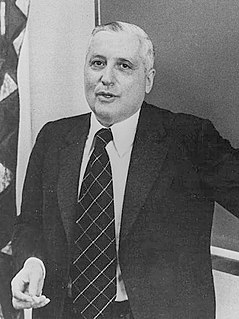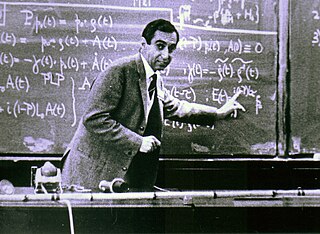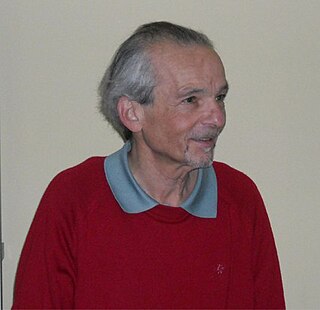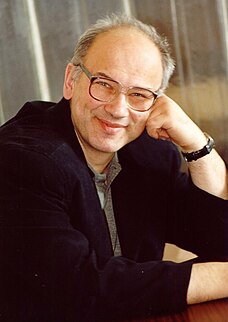Related Research Articles

Molecular diffusion,often simply called diffusion,is the thermal motion of all particles at temperatures above absolute zero. The rate of this movement is a function of temperature,viscosity of the fluid and the size (mass) of the particles. Diffusion explains the net flux of molecules from a region of higher concentration to one of lower concentration. Once the concentrations are equal the molecules continue to move,but since there is no concentration gradient the process of molecular diffusion has ceased and is instead governed by the process of self-diffusion,originating from the random motion of the molecules. The result of diffusion is a gradual mixing of material such that the distribution of molecules is uniform. Since the molecules are still in motion,but an equilibrium has been established,the result of molecular diffusion is called a "dynamic equilibrium". In a phase with uniform temperature,absent external net forces acting on the particles,the diffusion process will eventually result in complete mixing.
In physics,statistical mechanics is a mathematical framework that applies statistical methods and probability theory to large assemblies of microscopic entities. It does not assume or postulate any natural laws,but explains the macroscopic behavior of nature from the behavior of such ensembles.

Thermodynamics is a branch of physics that deals with heat,work,and temperature,and their relation to energy,entropy,and the physical properties of matter and radiation. The behavior of these quantities is governed by the four laws of thermodynamics which convey a quantitative description using measurable macroscopic physical quantities,but may be explained in terms of microscopic constituents by statistical mechanics. Thermodynamics applies to a wide variety of topics in science and engineering,especially physical chemistry,biochemistry,chemical engineering and mechanical engineering,but also in other complex fields such as meteorology.

Viscount Ilya Romanovich Prigogine was a physical chemist and Nobel laureate noted for his work on dissipative structures,complex systems,and irreversibility.
Thermodynamic equilibrium is an axiomatic concept of thermodynamics. It is an internal state of a single thermodynamic system,or a relation between several thermodynamic systems connected by more or less permeable or impermeable walls. In thermodynamic equilibrium there are no net macroscopic flows of matter or of energy,within a system or between systems. In a system that is in its own state of internal thermodynamic equilibrium,no macroscopic change occurs.
The fluctuation theorem (FT),which originated from statistical mechanics,deals with the relative probability that the entropy of a system which is currently away from thermodynamic equilibrium will increase or decrease over a given amount of time. While the second law of thermodynamics predicts that the entropy of an isolated system should tend to increase until it reaches equilibrium,it became apparent after the discovery of statistical mechanics that the second law is only a statistical one,suggesting that there should always be some nonzero probability that the entropy of an isolated system might spontaneously decrease;the fluctuation theorem precisely quantifies this probability.

Non-equilibrium thermodynamics is a branch of thermodynamics that deals with physical systems that are not in thermodynamic equilibrium but can be described in terms of macroscopic quantities that represent an extrapolation of the variables used to specify the system in thermodynamic equilibrium. Non-equilibrium thermodynamics is concerned with transport processes and with the rates of chemical reactions.
The Jarzynski equality (JE) is an equation in statistical mechanics that relates free energy differences between two states and the irreversible work along an ensemble of trajectories joining the same states. It is named after the physicist Christopher Jarzynski who derived it in 1996. Fundamentally,the Jarzynski equality points to the fact that the fluctuations in the work satisfy certain constraints separately from the average value of the work that occurs in some process.
The Green–Kubo relations give the exact mathematical expression for transport coefficients in terms of integrals of time correlation functions:

Denis James Evans,is an Australian scientist who is an Emeritus Professor at the Australian National University and Honorary Professor at The University of Queensland. He is widely recognised for his contributions to nonequilibrium thermodynamics and nonequilibrium statistical mechanics and the simulation of nonequilibrium fluids.
In physics,maximum entropy thermodynamics views equilibrium thermodynamics and statistical mechanics as inference processes. More specifically,MaxEnt applies inference techniques rooted in Shannon information theory,Bayesian probability,and the principle of maximum entropy. These techniques are relevant to any situation requiring prediction from incomplete or insufficient data. MaxEnt thermodynamics began with two papers by Edwin T. Jaynes published in the 1957 Physical Review.

Alexander Leonidovich Kuzemsky is a Russian theoretical physicist.

Peter Mazur was an Austrian-born,Dutch physicist and one of the founders of the field of non-equilibrium thermodynamics. He is the father of Harvard University physics professor Eric Mazur.
Dmitry Nikolaevich Zubarev was a Russian theoretical physicist known for his contributions to statistical mechanics,non-equilibrium thermodynamics,plasma physics,theory of turbulence,and to the development of the double-time Green function's formalism.
Energy dissipation and entropy production extremal principles are ideas developed within non-equilibrium thermodynamics that attempt to predict the likely steady states and dynamical structures that a physical system might show. The search for extremum principles for non-equilibrium thermodynamics follows their successful use in other branches of physics. According to Kondepudi (2008),and to Grandy (2008),there is no general rule that provides an extremum principle that governs the evolution of a far-from-equilibrium system to a steady state. According to Glansdorff and Prigogine,irreversible processes usually are not governed by global extremal principles because description of their evolution requires differential equations which are not self-adjoint,but local extremal principles can be used for local solutions. Lebon Jou and Casas-Vásquez (2008) state that "In non-equilibrium ... it is generally not possible to construct thermodynamic potentials depending on the whole set of variables". Šilhavý(1997) offers the opinion that "... the extremum principles of thermodynamics ... do not have any counterpart for [non-equilibrium] steady states ." It follows that any general extremal principle for a non-equilibrium problem will need to refer in some detail to the constraints that are specific for the structure of the system considered in the problem.

Bernard Howard Lavenda is a retired professor of chemical physics at the University of Camerino and expert on irreversible thermodynamics. He has contributed to many areas of physics,including that of Brownian motion,and in the establishment of the statistical basis of thermodynamics,and non-Euclidean geometrical theories of relativity. He was the scientific coordinator of the "European Thermodynamics Network" in the European Commission Program of Human Capital and Mobility. He was also a proponent for the establishment of,and scientific director of,a National (Italian) Centre for Thermodynamics,and has acted as scientific consultant to companies such as the ENI Group,where he helped to found TEMA,a consulting firm for SNAM Progetti,ENEA,and the Solar Energy Research Institute in Golden,Colorado. He has had over 130 scientific papers published in international journals,some critical of the new fashions and modes in theoretical physics.

Alexander Nikolaevich Gorban is a scientist of Russian origin,working in the United Kingdom. He is a professor at the University of Leicester,and director of its Mathematical Modeling Centre. Gorban has contributed to many areas of fundamental and applied science,including statistical physics,non-equilibrium thermodynamics,machine learning and mathematical biology.
Robert Walter Zwanzig was an American theoretical physicist and chemist who made important contributions to the statistical mechanics of irreversible processes,protein folding,and the theory of liquids and gases.
Gholam Ali Mansoori,G. Ali Mansoori also known as "GA Mansoori" is an Iranian-American scientist known for his research within energy,nanotechnology and thermodynamics. He is a professor at the Departments of Bioengineering,Chemical Engineering and also Physics at University of Illinois at Chicago.
Vladimir Nikolajevich Pokrovskii is a Russian scientist known for his original contributions to polymer physics and economic theory. He was the founder of the Altai school of dynamics of nonlinear fluids.
References
- ↑ Cheer, Angela; Mogilner, Alex; Stuchebrukhov, Alexi. "Joel E. Keizer". senate.universityofcalifornia.edu. University of California. Retrieved 25 May 2022.
- ↑ Shalizi, Cosma. "Canonical Theory in Chaotic Dynamics". cscs.umich.edu.
- ↑ J.E.K. "Principles of Thermodynamics: Nonequilibrium thermodynamics: Statistical Nonequilibrium Thermodynamics: Systems Far From Equilibrium". Encyclopædia Britannica, Inc.
- ↑ Oprişan, Sorinel Adrian. "About the Conservation Equations in Stochastic Canonical Theory" (PDF). phys.uaic.ro. Archived from the original (PDF) on 2012-03-25. Retrieved 2012-02-11.